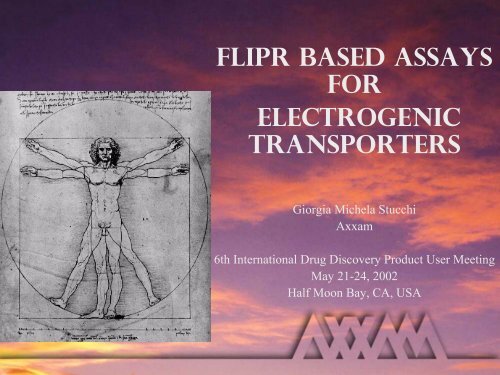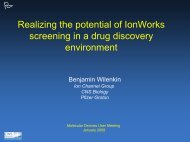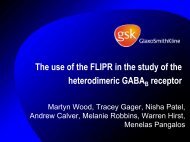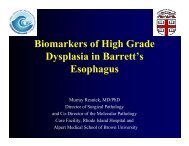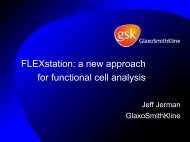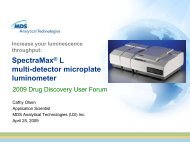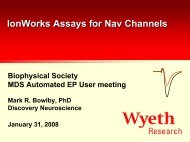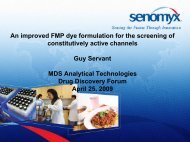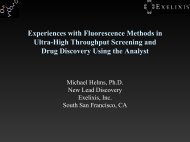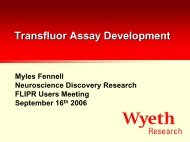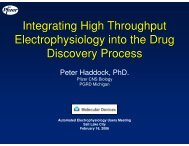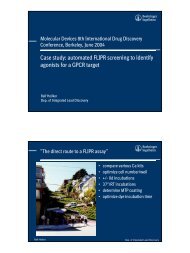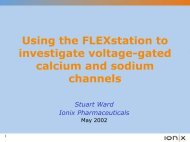tRANSPORtERS - Molecular Devices
tRANSPORtERS - Molecular Devices
tRANSPORtERS - Molecular Devices
You also want an ePaper? Increase the reach of your titles
YUMPU automatically turns print PDFs into web optimized ePapers that Google loves.
FLIPR based assays<br />
for<br />
electrogenic<br />
transporters<br />
Giorgia Michela Stucchi<br />
Axxam<br />
6th International Drug Discovery Product User Meeting<br />
May 21-24, 2002<br />
Half Moon Bay, CA, USA
TOPICS OF THE PRESENTATION<br />
Overview about AXXAM<br />
Overview about Transporters<br />
FLIPR based assays for a. GABA Transporters<br />
Conclusions<br />
b. Glycine Transporters
AXXAM<br />
AXXAM s.r.l. was founded at the 22nd of May 2001 at<br />
Milano<br />
AXXAM is located at the San Raffaele Science Park in<br />
Milano (Italy) and has more than 1400 square metres of fully<br />
equipped lab space<br />
The team consists of 45 people<br />
At the 8th of November 2001 a five years collaboration<br />
agreement (worth of 30 Million Euros) between BAYER AG<br />
and AXXAM was signed
BUSINESS of AXXAM:<br />
From Gene to screen<br />
Target<br />
identification<br />
Target<br />
•Ta<br />
validation<br />
Assay<br />
development<br />
Assay<br />
optimization for<br />
96, 384 or 1536<br />
Functional<br />
analysis<br />
Lead<br />
•Ta<br />
profiling<br />
Protein<br />
expression<br />
•Ta
Transporters<br />
Transporters are involved in different and essential cellular processes<br />
Transporters represent an interesting and growing target class for drug<br />
discovery<br />
Transporter in the genome<br />
Transporter types identified in vitro or in silico<br />
150 categories of transporters classified by Saier<br />
238 transporters in E.Coli<br />
250-500 transporters in yeast<br />
500-700 transporters in Drosophila (5% of genome)<br />
> 1000 transporters in human genome
Transporter families<br />
ion transporters & pumps<br />
- sodium-potassium ATPase<br />
- Organic Anion transporters (OATS)<br />
- Na/Ca exchangers<br />
metabolite transporters<br />
- Amino acids<br />
-Glucose<br />
- Lactate<br />
neurotrasmitter transporters<br />
- Vescicular<br />
-Plasma membrane
GABA transporter family (Na/Cl dependent)<br />
HUGO PRODUCT Substrate (preferred) coupling Locus (human)<br />
SLC6A1 GAT-1 -aminobutiric acid Na + /Cl - 3p25-p24<br />
SLC6A2 NAT1/NET1 norepinephrine Na + /Cl - 16q12.2<br />
SLC6A3 DAT1 dopamine Na + /Cl - 5p15.3<br />
SLC6A4 HTT serotonin Na + /Cl - 17q11.1-q12<br />
SLC6A5 GLYT-2 L-glycin Na + /Cl - 11p15.1-15.2<br />
SLC6A6 TAUT taurin Na + /Cl - 3p26-p24<br />
SLC6A6P pseudogene 21pter-qter<br />
SLC6A7 prot L-proline Na + /Cl - 5q31-q32<br />
SLC6A8 CT1/CRTR creatine Na + /Cl - Xq28<br />
SLC6A9 GLYT-1a to 1c L-glycin Na + /Cl - 1p33<br />
SLC6A10 CT-2 creatine Na + /Cl - 16p11.2<br />
SLC6A11 GAT-3 -aminobutiric acid Na + /Cl - reserved<br />
SLC6A12 BGT-1 -aminobutiric acid, Na + /Cl - 12p13<br />
betaine<br />
SLC6A13 GAT-2 -aminobutiric acid Na + /Cl - 12p13.3<br />
SLC6A14 hATB(0+ neutral, cationic amino acids Na + /Cl - Xq23-q24<br />
SLC6A15 hv7-3/homology reserved<br />
SLC6A16 homology reserved
Pathway for Transporters<br />
Expression profiling<br />
Cloning of the transporter gene<br />
Sequence verification<br />
Functional testing by “patch clamp” analysis<br />
Development of cell based assay for FLIPR<br />
platform
GABA TRANSPORTERS<br />
• belongs to the superfamily of sodium and chloride dependent neurotransmitter<br />
transporters<br />
• Four different GABA transporters (GATs) have been cloned up to now<br />
• GAT-1 and GAT-3 are high affinity neuronal transporters expressed specifically in the CNS<br />
• GAT-2 has a moderate affinity for GABA and is mainly found in glial cells<br />
• GAT-4 low affinity GABA transporter with distribution in glia, liver and kidney<br />
GABA (-aminobutyric acid) is the major inhibitory neurotrasmitter in the CNS.<br />
Termination of GABA transmission is achieved through high affinity GABA transport<br />
in both GABAergic neurons and glial cells<br />
A decrease in the GABAergic transmission has been implicated in the pathophysiology<br />
of several CNS disorders (e.g. epilepsy)
Stoichiometry of GABA transporters<br />
• net positive inward charge transfer<br />
• electrogenic (depolarization)<br />
• voltage sensitive dye (?)
Patch clamp analysis of GABA-induced current in<br />
HEK-293/hGAT-3 cells<br />
HEK-293 mock transfected cells
Voltage sensitive dye and FLIPR<br />
7500<br />
6719<br />
HEK-293/hGAT3<br />
5938<br />
•Fluorescence Counts<br />
5157<br />
4376<br />
3595<br />
2814<br />
2033<br />
1252<br />
471<br />
-310<br />
0 1 2 3 4<br />
HEK-293 mock<br />
100 uM GABA<br />
Time (minutes)
Membrane potential vs fluorescence changes<br />
on FLIPR in HEK-293/hGAT-3<br />
-20<br />
50 M GABA<br />
3000<br />
Membrane Potential (mV)<br />
-22<br />
-24<br />
-26<br />
-28<br />
2400<br />
1200<br />
600<br />
Fluorescence<br />
-30<br />
0<br />
-32<br />
0 10<br />
20 30 40<br />
50 60 70<br />
80<br />
Time (s)
Voltage sensitive dye-FLIPR<br />
GABA Dose-Response<br />
in HEK-293/hGAT3<br />
8500<br />
Fluorescence Counts<br />
7640<br />
6780<br />
5920<br />
5060<br />
4200<br />
3340<br />
2480<br />
1620<br />
760<br />
•buffer<br />
•2.5 M<br />
•5 M<br />
•10 M<br />
•20 M<br />
•40 M<br />
•80 M<br />
•160 M<br />
•320 M<br />
-100<br />
0 1 2 3 4<br />
Time(minutes)
HEK-293/hGAT-3<br />
EC 50 DETERMINATION<br />
Patch clamp vs FLIPR<br />
Fluorescence Change<br />
maximum RFU<br />
10000<br />
8000<br />
6000<br />
4000<br />
2000<br />
0<br />
HEK-293/hGAT3<br />
EC50 = 1.1 uM<br />
10 -7 10 -6 10 -5 10 -4 10 -3<br />
GABA (M)<br />
EC50 = 18 uM
Voltage sensitive dye-FLIPR<br />
-alanine Dose-Response<br />
in HEK-293/hGAT3<br />
RFU<br />
6000<br />
5000<br />
4000<br />
3000<br />
2000<br />
EC50= 184 uM<br />
maximum RFU<br />
1000<br />
Fluorescence Counts<br />
4600<br />
4123<br />
3646<br />
3169<br />
2692<br />
2215<br />
1738<br />
1261<br />
784<br />
307<br />
-170<br />
0<br />
20 40 60 80 100 120 140 160 180 200<br />
Time(seconds)<br />
•buffer<br />
•15 M<br />
•31 M<br />
•62.25 M<br />
•125 M<br />
•250 M<br />
•500 M<br />
•1 mM<br />
•2 mM<br />
0<br />
10 -6 10 -5 10 -4 10 -3 10 -2<br />
-alanine
Patch clamp: GABA-induced current<br />
in HEK-293/rGAT-1
Voltage sensitive dye-FLIPR<br />
GABA Dose Response HEK-293/rGAT1<br />
17000<br />
Fluorescence Counts<br />
15200<br />
13400<br />
11600<br />
9800<br />
8000<br />
6200<br />
4400<br />
2600<br />
800<br />
-1000<br />
0 1 2 3 4<br />
Time(minutes)<br />
• buffer<br />
• 2.5 uM<br />
• 5 uM<br />
• 10 uM<br />
• 20 uM<br />
• 40 uM<br />
• 80 uM<br />
• 160 uM<br />
• 320 uM
HEK-293/rGAT-1<br />
EC 50 DETERMINATION<br />
Patch clamp vs FLIPR<br />
20000<br />
maximun FLU<br />
10000<br />
maximum RFU<br />
0<br />
10 -6 10 -5 10 -4 10 -3<br />
GABA<br />
EC50 = 10.5 M<br />
EC50 = 43.4 M
Raw data GABA dose response<br />
buffer 1 uM 10 uM 50 uM 100 uM 200 uM<br />
HEK-293/hGAT3<br />
HEK-293/rGAT1<br />
Range = ( -2000, 28000 )<br />
• Robust signal<br />
• Good signal:noise<br />
• Good well to well reproducibility<br />
•No wash
Glycine Transporters<br />
Glycine Transporters are members of the Na + /Cl - -dependent family, a group of<br />
integral glycoproteins, with 12 transmembrane domains.<br />
Two glycine transporters subtypes have been identified:<br />
GlyT1<br />
Three isoforms are known: GlyT-1a<br />
GlyT-1b<br />
GlyT-1c<br />
GlyT-1c expression is highly restricted to Brain.<br />
GlyT2<br />
is mainly expressed in spinal cord, brainstem and cerebellum and is present mostly on<br />
neuronal cells.<br />
Many polymorphisms in human GLYT2 has been identified
Glycine 2 mM<br />
Glycine-induced current<br />
in HEK-293/ GlyT2<br />
Glycine 2 mM<br />
Non transfected cells<br />
n=6/6<br />
120<br />
100<br />
current<br />
80<br />
60<br />
GlyT2 transfected cells<br />
n=8/9<br />
40<br />
20<br />
0<br />
10 -5 10 -4 10 -3 10 -2 10 -1<br />
Glycine<br />
EC50=98,21 µM
Voltage sensitive dye-FLIPR<br />
Glycine Dose-Response<br />
HEK-293/hGlyT2<br />
Fluorescence Counts<br />
3200<br />
2870<br />
2540<br />
2210<br />
1880<br />
1550<br />
1220<br />
890<br />
560<br />
230<br />
-100<br />
0 1 2 3 4 5<br />
Time(minutes)<br />
• buffer<br />
• 1 uM<br />
• 10 uM<br />
• 100 uM<br />
• 1 mM<br />
• 10 mM
Glycine 2 mM<br />
Glycine-induced current<br />
in HEK-293/ hGlyT1<br />
EC50 determination by patch clamp<br />
150<br />
o fImax)<br />
%<br />
u rrent( c<br />
100<br />
50<br />
0<br />
EC50= 9.537 uM<br />
-7 -6 -5 -4 -3 -2 -1<br />
Glycine
Voltage sensitive dye-FLIPR<br />
Glycine Dose-Response<br />
HEK-293/hGlyT1<br />
Fluorescence Change (Counts)<br />
1700<br />
1520<br />
1340<br />
1160<br />
980<br />
800<br />
620<br />
440<br />
260<br />
80<br />
-100<br />
0 1 2 3 4 5<br />
Time(minutes)<br />
• buffer<br />
• 1 uM<br />
• 10 uM<br />
• 100 uM<br />
• 1 mM<br />
• 10 mM
Glycine transporters<br />
Fluorescence Counts<br />
3600<br />
3230<br />
2860<br />
2490<br />
2120<br />
1750<br />
1380<br />
1010<br />
640<br />
270<br />
-100<br />
0 1 2 3 4 5<br />
10 mM glycine<br />
Time(minutes)<br />
HEK-293/hGlyT2<br />
HEK-293/hGlyT1<br />
HEK-293
Summary<br />
Voltage sensitive dye and FLIPR can be applied to the study of<br />
electrogenic transporters<br />
Good correlation between patch clamp and FLIPR data for GABA<br />
transporters were demonstrated<br />
Studies on glycine transporters are still on going.<br />
From preliminary data a weaker correlation between patch clamp and<br />
FLIPR data was observed<br />
These results showed the feasibility of FLIPR based HTS screening for<br />
electrogenic transporter modulators
Acknowledgements<br />
Silvia Bovolenta<br />
Sabrina Corazza<br />
Anna Della Bella<br />
Maria Foti<br />
Maria Micheletti<br />
Elisa Redaelli<br />
Frank Hafner (<strong>Molecular</strong> <strong>Devices</strong>)


